With the great variety of knapweed species, there is something for everyone. With its extraordinary flowers, the knapweed delights not only us, but also many insects.

Next to it is the knapweed (Centaurea) also edible. We provide an overview of the most beautiful species and show you how to plant and care for the knapweed.
contents
- Knapweed: characteristics and origin
- The most beautiful species and varieties
- Planting knapweed: sowing and location
- The correct care of knapweed: cutting and Co.
- Medicinal effects and uses
- Is the knapweed poisonous?
Knapweed: characteristics and origin
With the knapweeds (Centaurea) is a genus of plants that belongs to the sunflower family (Asteraceae). The genus is widespread in Europe and the Middle East and includes around 260 species. These are characterized by their paniculate, racemose arranged flowers, which appear frayed due to the many small individual flowers. The bracts typical of the knapweed are conspicuous and arranged like roof tiles. Depending on the species, the knapweed blooms between May and August. She then presents her flowers in colors ranging from yellow to pink to blue. The knapweed leaves can be undivided and lanceolate or pinnate. Some species have green, others silvery or hairy foliage. Knapweeds can reach heights of between 20 and 300 cm.
Is the knapweed perennial? Yes! In most species of the genus Centaurea it is a perennial perennial. However, there are also some annual and biennial species.
If the knapweed was fertilized during the flowering period, fruits with long, feathery hairs appear. These hair extensions are also known as pappus. It looks something like the dandelion's dandelion. This allows the seeds to be carried away by the wind and the knapweed to spread. In addition, knapweeds form runners, with the help of which they form large stands.
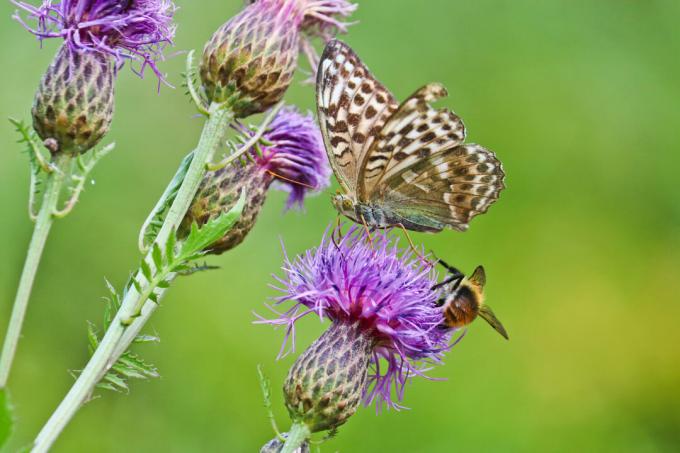
Tip: Since there is still not entirely agreement on many species as to whether they are botanically part of the genus Centaurea belong or not, up to 700 species are sometimes ascribed to the knapweed.
The most beautiful species and varieties
In addition to the different types of knapweed, there are also many garden types that have a wide variety of colors and sizes. Here we have put together a small overview of the most beautiful species:
- Mountain knapweed (Centaurea montana): The mountain knapweed has flowers that are reddish-purple on the inside and blue on the outside. At 30 - 40 cm, it remains quite small and blooms relatively early, namely as early as May. The mountain knapweed likes to grow in a sunny or partially shaded location in dry to fresh soil.

- Purple knapweed (Centaurea atropurpurea): As the name suggests, the purple knapweed (also known as the red mountain knapweed) blooms in purple. It grows up to 125 cm high and its flowers appear in July and August. The purple knapweed needs a well-drained garden soil and plenty of sun.

- Giant knapweed (Centaurea macrocephala): With a height of 150 cm, this species becomes quite large and otherwise has a strong appearance. It flowers yellow and is native to the Caucasus. It needs nutrient-rich, fresh soil that can be humus.
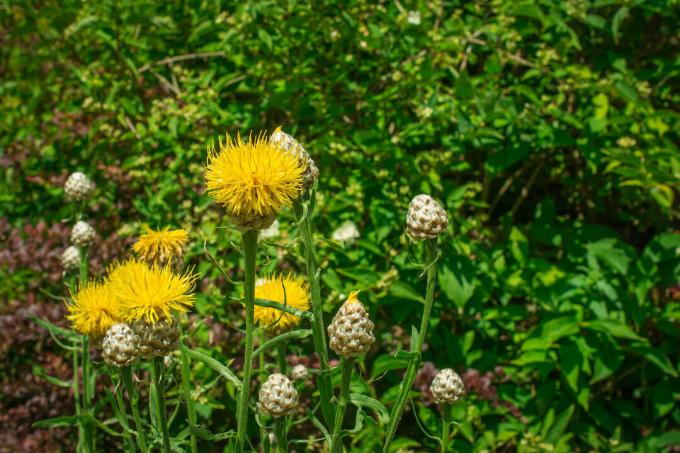
- Meadow knapweed (Centaurea jacea): One of the best-known and most common species is the meadow knapweed or common knapweed. They are also often found wild. It blooms purple and is also very popular with bees. The size varies between 30 and 70 cm. The meadow knapweed grows well in dry to fresh soil in full sun. It can even exist on very shallow subsoil with only a few centimeters of earth above a rock layer.
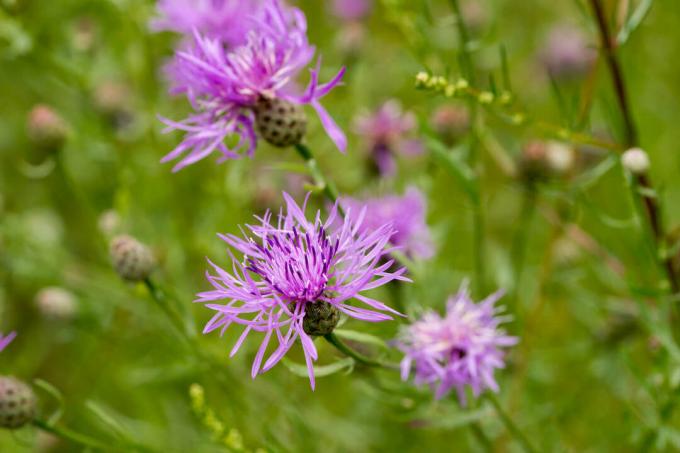
- Scabiosa knapweed (Centaurea scabiosa): The scabiosa knapweed looks very similar to the meadow knapweed. They bloom in June. It reaches heights of 120 cm. Scabiosa knapweed feel in good hands in partial shade or full sun on dry to fresh ground.
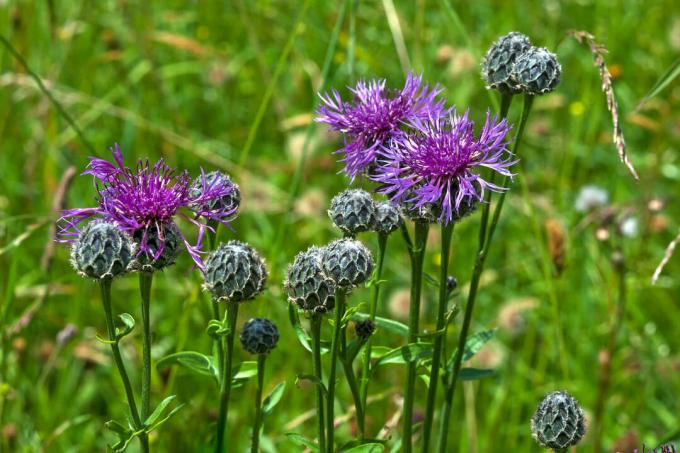
- White mountain knapweed (Centaurea montana 'Alba'): This variety blooms a little longer than the wild form, namely from May to July and shines in bright white. It has the same location requirements as Art Centaurea montana.

- Panicle knapweed (Centaurea stoebe): This species is heavily branched and has light purple flowers. The whole plant is covered with fine hairs, the leaves are quite small. It prefers a very well drained, rather stony and dry subsoil in full sun, warm locations. The panicle knapweed is to be confused with the panicle knapweed (Centaurea paniculata). However, this is a different species.

- Black knapweed (Centaurea nigra): In contrast to some other knapweeds, this species only has flowers of the same length. The name comes from the appendages of the bracts, which are colored black here. The black knapweed needs a full sun, especially a warm location and tolerates dry soils as well as fresh soils.
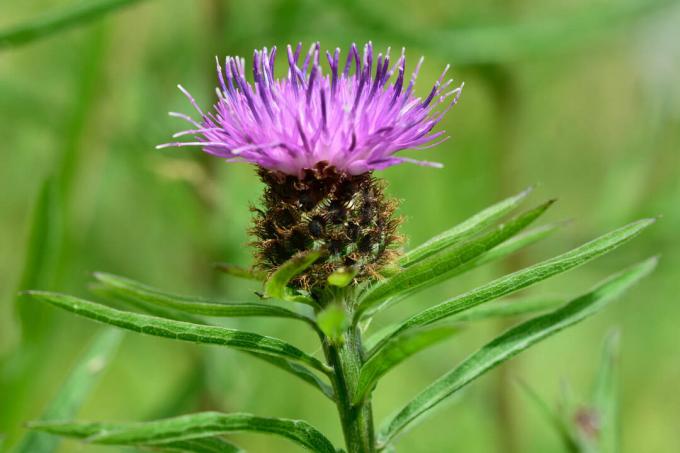
- Two-tone knapweed (Centaurea dealbata): The two-colored knapweed is a mountain plant. The flowers are pink and usually lighter on the inside than on the outside. Sunny or shady areas in the garden with dry to fresh soil appeal to the two-colored knapweed.
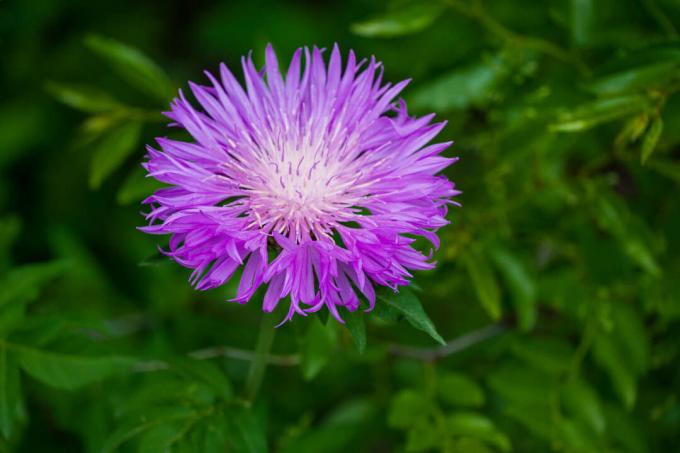
Tip: the Cornflower is sometimes called Centaurea cyanus and partly as Cyanus segetum described. Whether the annual cornflower also belongs to the genus of knapweed is controversial.
Planting knapweed: sowing and location
Who one Centaurea want to plant, the knapweed should seek a location in the sun. For some species, such as the giant knapweed, the soil is ideally fresh, loose, humus and nutrient-rich, weakly acidic or weakly alkaline. Other species, such as the black knapweed, however, require a humus-poor, stony and well-drained soil. It is best to mix in a little powdered clay and potting soil on extremely sandy soils.
Direct sowing of the knapweed seeds in the garden can be done in spring from April.
Before that, you can also prefer the seeds of the knapweed indoors. To do this, fill pots with soil, gently press the seeds into them and put a bell jar over them. Keep the whole thing moist and place the container in a place about 20 ° C. Germination is usually slow and irregular. After germination, you should find a slightly cooler place for the plants.
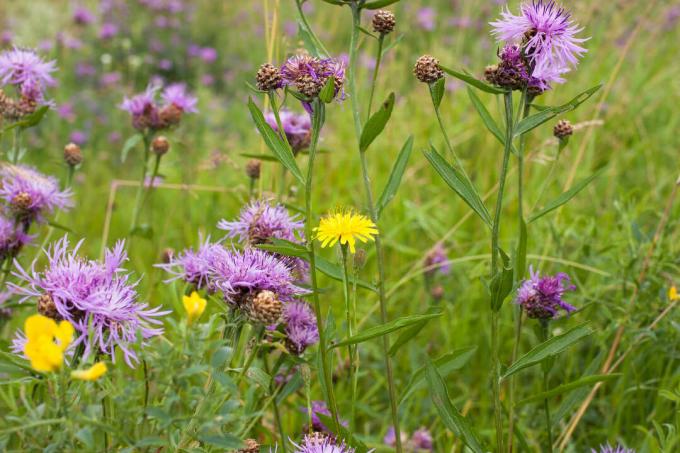
From the end of April you can Centaurea- Young plants are planted outdoors. A planting distance of about 40 cm should be maintained. Soak the root ball in water before planting. The soil in the bed should best with a nutrient-rich substrate, such as ours Plantura organic potting soilto be enriched. Our earth remains structurally stable for a long time and can store water well so that the knapweed roots neither wet nor dry out. It also provides important nutrients. You can also use our potting soil for growing the knapweed seeds.
The correct care of knapweed: cutting and Co.
The knapweed care consists of watering, fertilizing and cutting in a very classic way. So you can enjoy the pretty perennial for a long time.
The knapweed does not actually have to be watered at a suitable location. If it is on very sandy soil or in the blazing sun, it should be watered occasionally.
Fertilization is also important for some species, such as the giant knapweed, so that they can grow well. It is best to use a slow release fertilizer such as ours Plantura organic flower fertilizer. This contains all the important nutrients for roots, leaves and flowers and ensures that your flowers flourish. One application in spring and one in late summer are sufficient here, as our flower fertilizer with its long-term effect lasts for three months.
After flowering, you should cut the knapweed so that it can sprout again. So it comes to a second flowering in early autumn. The cut knapweed is also ideal as a cut flower in the vase. If you want the knapweed to spread, you should let the second flower stand so that seeds can start to form.
Tip: If you want to use the knapweed as a cut flower, it is best to cut it shortly before the flower opens. However, this gives the bees less of the perennial.
Is the knapweed hardy? Not all knapweeds are hardy. However, the above species have no problem with frosty temperatures. Some others, such as the solstice knapweed (Centaurea solstitialis), but are only annual and not winter hardy.
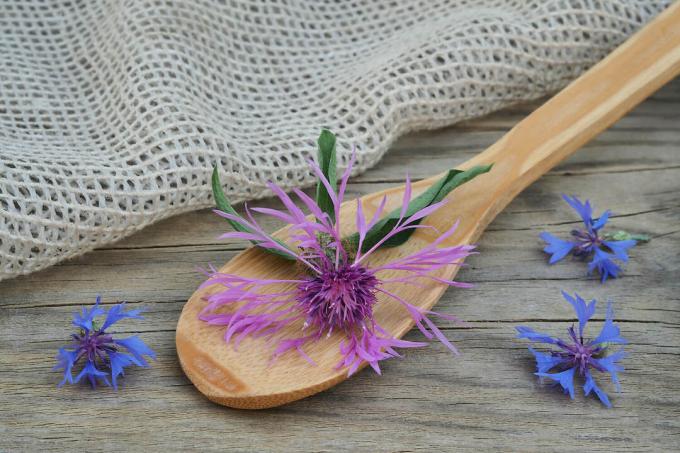
Medicinal effects and uses
The common meadow knapweed (Centaurea jacea) is edible. Leaves, shoot tips, flowers and also the roots are used. The bitter substances contained in the roots and leaves are said to aid digestion. For example, tea can be brewed from the plant parts. In the past, the knapweed was also used in medicine against scabies and eye diseases. The flowers taste neutral and are often used to decorate dishes.
Is the knapweed poisonous?
The knapweed is not poisonous and therefore poses no danger to children or pets. The common meadow knapweed is also no problem on the horse pasture.
The cornflower looks very similar to the knapweed and used to belong to the knapweed genus. We'll show you how to do the Plant and care for cornflowers and how to use them in the kitchen.
